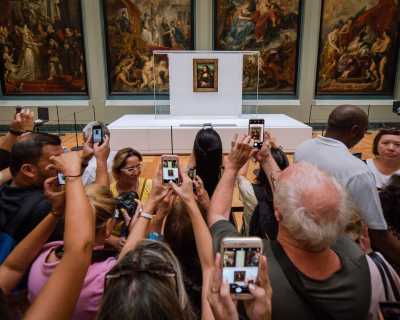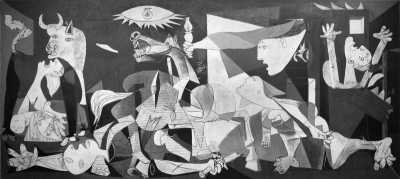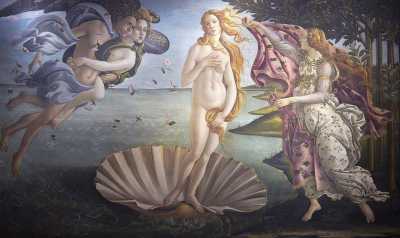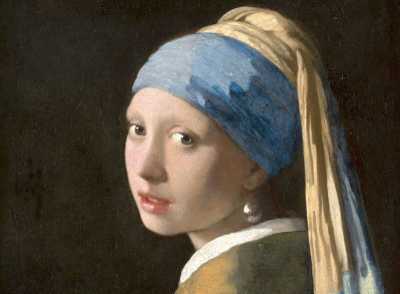The 10 most famous paintings in the world
Art has the power to move us, to inspire us, and to make us feel a whole range of emotions. Throughout history, artists have created masterpieces that have stood the test of time and continue to captivate audiences to this day. Making a list of the 10 most famous paintings in the world is no easy feat, as it is an incredibly subjective task. However, we have compiled a list of 10 of the most well-known paintings in the world, each one a unique masterpiece in its own right.
Note that the paintings are not arranged in any particular order, the criteria used were simply to not repeat any author, and to select paintings on canvas, excluding series. For instance, if we had included another painting by Leonardo da Vinci, it would have been a difficult choice, given his numerous well-known works, such as The Last Supper or the Vitruvian Man. Additionally, while Michelangelo's Sistine Chapel and Monet's Water Lilies are undoubtedly iconic pieces of art that should have been included, but they do not meet the criteria we set for this list.
While this list is by no means comprehensive, these 10 paintings have certainly earned their place in the canon of art history, and continue to inspire and move us today.
Table of contents
- Mona Lisa by Leonardo da Vinci
- The Starry Night by Vincent van Gogh
- The Scream by Edvard Munch
- Guernica by Pablo Picasso
- The Persistence of Memory by Salvador Dalí
- The Birth of Venus by Sandro Botticelli
- The Night Watch by Rembrandt van Rijn
- Las Meninas by Diego Velázquez
- Girl with a Pearl Earring by Johannes Vermeer
- The Kiss by Gustav Klimt
-
Mona Lisa
 Mona Lisa (detail) Leonardo da Vinci, Public domain, via Wikimedia Commons
Mona Lisa (detail) Leonardo da Vinci, Public domain, via Wikimedia Commons - Artist: Leonardo da Vinci
- Year: c. 1503–1506
- Where to see it: Louvre Museum, Paris, France
The Mona Lisa is perhaps the most famous painting in the world. It depicts a woman, believed to be Lisa Gherardini, the wife of Francesco del Giocondo. The painting's enigmatic smile and gaze have captured the imaginations of viewers for centuries.
The painting, also known as La Gioconda, was created by the Italian Renaissance artist Leonardo da Vinci in the early 16th century. The painting is small, measuring just 30 x 21 inches (77 x 53 cm), and is painted in oil on a panel of poplar wood.
The Mona Lisa is famous not only for its subject matter, but also for its composition and technique. The figure of Lisa is set against a landscape of mountains and water, and she is painted with a technique known as sfumato, where the colors are blended together in a soft and hazy way.
The painting has had a fascinating history, including being stolen from the Louvre Museum in Paris in 1911, and having various interpretations and theories surrounding its subject matter and symbolism. Today, it remains one of the most popular and recognizable works of art in the world, and is visited by millions of people each year at the Louvre.
-
The Starry Night
 The Starry Night Vincent van Gogh, Public domain, via Wikimedia Commons
The Starry Night Vincent van Gogh, Public domain, via Wikimedia Commons- Artist: Vincent van Gogh
- Year: 1889
- Where to see it: Museum of Modern Art, New York, USA
The Starry Night is an oil painting that depicts the view from Van Gogh's room at the Saint-Paul-de-Mausole asylum in France. The painting is famous for its swirling sky, which is meant to represent Van Gogh's emotions at the time.
The Starry Night was painted by Vincent van Gogh in 1889, during his stay at the asylum where he had admitted himself after suffering from a mental breakdown. The painting depicts a view from his window at the asylum, looking out over the village of Saint-Rémy-de-Provence in the south of France.
The swirling sky in the painting, with its bright stars and crescent moon, has become one of the most recognizable images in art history. Van Gogh's use of color and texture in the painting is also notable, with thick brushstrokes and bold, contrasting hues.
Despite its current status as one of the most famous paintings in the world, The Starry Night was not well-received during Van Gogh's lifetime. It was only after his death that his work gained widespread recognition and acclaim. Today, the painting is part of the permanent collection of the Museum of Modern Art in New York City, where it is one of the museum's most popular and frequently visited works.
-
The Scream
 The Scream (detail) Edvard Munch, Public domain, via Wikimedia Commons
The Scream (detail) Edvard Munch, Public domain, via Wikimedia Commons- Artist: Edvard Munch
- Year: 1893
- Where to see it: National Gallery, Oslo, Norway
The Scream is a painting that depicts a person screaming against a blood-red sky. The figure is often interpreted as a representation of human anxiety and existential dread.
The Scream is a painting created by the Norwegian artist Edvard Munch in 1893. The painting is part of a series of works that Munch created under the title "The Frieze of Life," which explores themes of love, anxiety, and death.
The painting depicts a figure with a distorted face and hands held up to the ears, standing against a background of swirling colors and a blood-red sky. The painting's bold colors and expressive brushstrokes give it a sense of emotional intensity that has made it one of the most iconic works of art in the world.
The figure in The Scream is often interpreted as a representation of human anxiety and existential dread, reflecting the mood of uncertainty and unease that pervaded late 19th-century Europe. The painting has become a symbol of modern angst and has been referenced and parodied in popular culture countless times.
There are actually four versions of The Scream: two paintings, a pastel drawing, and a lithograph. One of the paintings is housed in the National Gallery in Oslo, Norway, while the other is in the collection of the Munch Museum, also in Oslo. The pastel version of the painting sold at auction for nearly $120 million in 2012, making it one of the most expensive works of art ever sold.
-
Guernica
 Guernica. Photo by Magall, CC BY-NC-ND 2.0
Guernica. Photo by Magall, CC BY-NC-ND 2.0 - Artist: Pablo Picasso
- Year: 1937
- Where to see it: Museo Reina Sofia, Madrid, Spain
Guernica is a painting that depicts the bombing of the town of Guernica during the Spanish Civil War. The painting is famous for its use of abstract and distorted forms to convey the horror and violence of the event.
Guernica is a large-scale painting created by the Spanish artist Pablo Picasso in 1937. The painting was created in response to the bombing of the town of Guernica during the Spanish Civil War, which was carried out by German and Italian warplanes at the request of the Nationalist forces under the leadership of General Franco.
The painting depicts the horror and violence of the bombing using a range of abstract and distorted forms. The central figure in the painting is a horse, which is shown writhing in agony with a gaping wound in its side. Other figures, including a woman with an upraised arm and a bull, are also depicted in fragmented and distorted forms. The painting's monochromatic color scheme of black, white, and grey adds to its sense of bleakness and despair.
Guernica has become one of the most famous anti-war paintings in the world, and it remains a powerful symbol of the atrocities of war. It has been interpreted in a variety of ways, with some seeing it as a condemnation of the fascist regimes that were gaining power in Europe at the time, and others seeing it as a broader statement about the human cost of war and violence.
Today, Guernica is housed in the Museo Reina Sofia in Madrid, where it is one of the museum's most prized possessions. It is also one of the most frequently visited works of art in Spain, and it continues to inspire and provoke viewers more than 80 years after its creation.
-
The Persistence of Memory
 The Persistence of Memory, Photo by Mike Steele, CC BY 2.0
The Persistence of Memory, Photo by Mike Steele, CC BY 2.0- Artist: Salvador Dalí
- Year: 1931
- Where to see it: Museum of Modern Art, New York, USA
The Persistence of Memory is a surrealist painting that depicts a landscape with melting clocks. The painting is meant to represent the fluidity of time and the subjective nature of reality.
The Persistence of Memory is a surrealist painting created by the Spanish artist Salvador Dali in 1931. The painting depicts a desolate landscape with melting watches draped over various objects, including a distorted face in the center of the painting. The painting's dreamlike quality is heightened by the presence of an insect-like creature with a distorted body that seems to be melting into the landscape.
The painting's melting clocks have become one of the most recognizable images in the history of modern art, and they have been interpreted in a variety of ways. Some critics have suggested that the melting clocks represent the fluidity of time, and the fact that time is a subjective experience that can feel different depending on one's perspective. Others have suggested that the clocks are a reference to the theory of relativity, which was a revolutionary idea in the field of physics around the time the painting was created.
Dali was heavily influenced by the ideas of Sigmund Freud and other psychoanalysts, and The Persistence of Memory has been interpreted as a representation of the subconscious mind. The melting watches, distorted faces, and other surreal elements of the painting are meant to evoke the strange and unpredictable nature of dreams and the workings of the human psyche.
Today, The Persistence of Memory is housed in the Museum of Modern Art (MoMA) in New York City, where it is one of the most popular and frequently visited works in the museum's collection. It remains one of the most iconic images of surrealism, and it continues to fascinate and intrigue viewers more than 90 years after its creation.
-
The Birth of Venus
 Sandro Botticelli, CC BY-SA 4.0, via Wikimedia Commons
Sandro Botticelli, CC BY-SA 4.0, via Wikimedia Commons - Artist: Sandro Botticelli
- Year: c. 1485
- Where to see it: Uffizi Gallery, Florence, Italy
The Birth of Venus is a painting that depicts the Roman goddess of love emerging from the sea. The painting is famous for its composition and use of color, and is considered one of the greatest masterpieces of the Italian Renaissance.
The Birth of Venus is a painting created by the Italian artist Sandro Botticelli in the mid-1480s. The painting depicts the goddess Venus, or Aphrodite in Greek mythology, standing in a seashell and being blown towards the shore by Zephyrus, the god of the west wind. On the right side of the painting, a female figure, likely one of the Horae, or goddesses of the seasons, reaches out to clothe Venus with a floral garment.
The painting is notable for its graceful composition and use of color. Botticelli was known for his ability to create delicate, flowing lines, and The Birth of Venus showcases this skill to great effect. The painting's soft, pastel colors and delicate brushstrokes create a sense of ethereal beauty and otherworldliness.
The Birth of Venus was created during the Italian Renaissance, a period of great artistic and intellectual activity in Italy and throughout Europe. The painting reflects the Renaissance interest in classical mythology and humanism, which emphasized the value of human experience and knowledge.
Today, The Birth of Venus is housed in the Uffizi Gallery in Florence, Italy, where it is one of the museum's most popular and frequently visited works. The painting continues to be admired and studied for its beauty and for its importance in the history of Italian Renaissance art.
-
The Night Watch
 The Night Watch (detail) Rembrandt, Public domain, via Wikimedia Commons
The Night Watch (detail) Rembrandt, Public domain, via Wikimedia Commons- Artist: Rembrandt van Rijn
- Year: 1642
- Where to see it: Rijksmuseum, Amsterdam, Netherlands
The Night Watch is a painting that depicts a group of militia men in Amsterdam. The painting is famous for its use of light and shadow, and its dynamic composition.
The Night Watch is a painting created by the Dutch artist Rembrandt van Rijn in 1642. The painting depicts a group of militia men led by Captain Frans Banninck Cocq and his lieutenant, Willem van Ruytenburch, who are preparing to march out. The painting is also known as The Company of Frans Banninck Cocq and Willem van Ruytenburch.
The Night Watch is notable for its size, measuring approximately 11.91 feet by 14.34 feet. It is also known for its use of light and shadow, which creates a dramatic and dynamic effect. The painting is lit from the left side, with the light falling on the figures in the center of the painting. The figures on the right side are partially in shadow, which adds to the painting's sense of depth and realism.
The Night Watch was created during the Dutch Golden Age, a period of great artistic and economic prosperity in the Netherlands. The painting reflects the Dutch interest in civic pride and patriotism, and the importance of civic militias in maintaining order and protecting the country.
Today, The Night Watch is housed in the Rijksmuseum in Amsterdam, where it is one of the museum's most famous and prized possessions. The painting is considered a masterpiece of Dutch Baroque art and is admired for its complex composition, use of light and shadow, and realistic portrayal of the figures.
-
Las Meninas
 Diego Velázquez, Public domain, via Wikimedia Commons
Diego Velázquez, Public domain, via Wikimedia Commons - Artist: Diego Velázquez
- Year: 1656
- Where to see it: Museo del Prado, Madrid, Spain
Las Meninas is a painting that depicts the Spanish royal family and their courtiers. The painting is famous for its use of perspective and its complex composition, which has been the subject of much analysis and interpretation.
Las Meninas is a painting by the Spanish artist Diego Velázquez. It was painted in 1656 and depicts the Spanish royal family, including King Philip IV and his wife Queen Mariana, surrounded by their courtiers and servants. The painting is considered one of the greatest masterpieces of the Spanish Golden Age.
Las Meninas is notable for its use of perspective and its complex composition. Velázquez created a sense of depth by using a vanishing point located behind the figures in the painting, which draws the viewer's eye to the center of the canvas. The painting is also notable for its large size, measuring approximately 10 feet by 9 feet.
The painting's composition has been the subject of much analysis and interpretation. Some art historians have suggested that Velázquez included himself in the painting, reflected in the mirror at the back of the room. Others have suggested that the painting is a comment on the role of the artist in society, with Velázquez portrayed as a member of the court rather than as an outsider.
Today, Las Meninas is housed in the Museo del Prado in Madrid, where it is one of the museum's most popular and prized possessions. The painting is admired for its skillful execution, complex composition, and innovative use of perspective, and is considered a masterpiece of Baroque art.
-
Girl with a Pearl Earring
 Girl with a Pearl Earring (detail) Johannes Vermeer, Public domain, via Wikimedia Commons
Girl with a Pearl Earring (detail) Johannes Vermeer, Public domain, via Wikimedia Commons- Artist: Johannes Vermeer
- Year: 1665
- Where to see it: Mauritshuis museum, The Hague, Netherlands
"Girl with a Pearl Earring" is a painting by the Dutch artist Johannes Vermeer. The painting depicts a young woman wearing a blue and gold turban and a large pearl earring. The background is dark and the lighting is dramatic, with the light falling on the girl's face and earring. The painting is considered a masterpiece of Dutch Golden Age painting and is one of Vermeer's most famous works."
"Girl with a Pearl Earring" is a painting by Johannes Vermeer, a Dutch artist of the 17th century. The painting portrays an anonymous young woman wearing a blue and gold turban and a large pearl earring. The background of the painting is dark, creating a dramatic effect, and the lighting is focused on the girl's face and earring, giving them a luminous quality. The painting is widely considered a masterpiece of Dutch Golden Age painting and is one of Vermeer's most famous works.
Despite its popularity, the identity of the girl in the painting remains a mystery. Some art historians speculate that she may have been a maid in Vermeer's household, while others believe that she could have been a real-life model or even an idealized portrait of the artist's wife. Regardless of her identity, the girl's enigmatic expression and the painting's use of light and shadow have captured the imagination of viewers for centuries. Today, "Girl with a Pearl Earring" can be seen at the Mauritshuis museum in The Hague, Netherlands, where it remains a beloved and iconic piece of art.
-
The Kiss
 The Kiss (detail) Gustav Klimt, Public domain, via Wikimedia Commons
The Kiss (detail) Gustav Klimt, Public domain, via Wikimedia Commons - Artist: Gustav Klimt
- Year: 1907-1908
- Where to see it: Österreichische Galerie Belvedere, Vienna, Austria
The Kiss is a painting that depicts a couple embracing and kissing, surrounded by ornate and decorative patterns. The painting is famous for its sensual and erotic subject matter, as well as its use of gold leaf and other decorative elements.
"The Kiss" is a painting by the Austrian artist Gustav Klimt, created during the height of the Art Nouveau movement in 1907-1908. The painting features a couple locked in a passionate embrace and kiss, with the man bending over the woman and both figures surrounded by a golden aura. The elaborate and ornate patterns in the background are characteristic of Klimt's signature style, which often combined traditional painting techniques with decorative elements inspired by the art of ancient Egypt and Byzantium.
The painting is widely regarded as one of Klimt's masterpieces and is celebrated for its sensual and erotic subject matter. The embrace of the two figures is intimate and intense, conveying a sense of intense emotion and desire. The use of gold leaf and other decorative elements adds to the painting's luxurious and sensuous qualities, and has contributed to its enduring popularity and influence.
"The Kiss" can be seen at the Österreichische Galerie Belvedere in Vienna, Austria, where it is considered one of the museum's most important works. It has also been the subject of numerous reproductions and adaptations, and is widely recognized as one of the most iconic images in the history of art.
These 10 paintings are not only iconic works of art but also masterpieces that are well worth a visit to see in person. Each painting tells a unique story and offers a glimpse into the artistic genius of its creator. From the enigmatic smile of the Mona Lisa to the swirling stars of The Starry Night, these paintings have captivated audiences for generations and continue to inspire and move us today.
So, if you have the opportunity, we highly recommend visiting the museums where these paintings are housed to experience their beauty and power firsthand.










